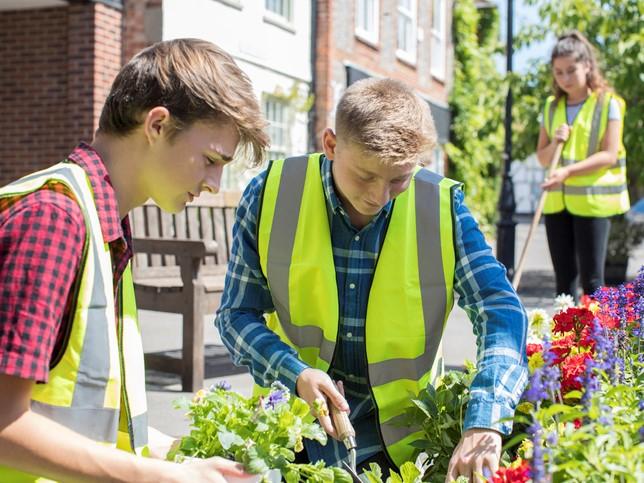Back in the day the UK Government’s Manpower Services Commission enabled a flotilla of community-based projects, undertaken as retraining, by people out of paid work. In Northumberland, for example, a community trust enlisted the help of tens of unemployed people to regenerate the village of Allenheads (in England’s North Pennines). Wouldn’t it be amazing to repeat such success stories, and – at the same time – build the capacity of those yet to go to university?
This suggestion is built on the back of my own post-school gap year in 1975, during which I worked as a community service volunteer with a London borough’s social services team. Boy, aged 17, I sure grew up fast. The experience has never left me, and that’s why I piloted the Big Green Gap Year (BiGGY) during 2015, supported by the NUS and University of Gloucestershire.
Simply put, the BiGGY enabled about 10 Gloucestershire-based school leavers to undertake two placements, in which the “gappers” undertook community or environmental projects that organisations would otherwise be unable to proceed with.
- Tips for involving young people in research in meaningful ways
- Make a difference: collaboration and participation in arts-led research
- How a sustainable internship programme can support social mobility
Placements included helping a constituency Green Party assemble its election material; another student researched and published findings for a GP practice on social prescribing – that is prescribing community work to alleviate mental health disorders; a third helped assemble a conservation strategy for an SSSI (Site of Special Scientific Interest).
Each project sponsor, in tandem with an NUS Green Fund grant, ensured that individuals on the BiGGY were paid a living wage. This was an important principle: that each teenager was not just used as cheap labour.
As the Alliance for Sustainability Leadership in Education noted, participants “explicitly commented on the deepening of their sustainability understanding, knowledge and skills as a result of the training and experience gained throughout their BiGGY experience. This, combined with the early integration into university life, demonstrates BiGGY’s role in promoting transformative learning for sustainability to support development of forward-thinking, engaged learners who will become proactive members of their universities.”
The 2015 BiGGY pilot evaluation noted that “100 per cent of placement hosts stated the BiGGY participants added value to their organisations; that they would recommend BiGGY to other organisations…the contributions participants made to Gloucestershire organisations supported them to become agents of positive change…whilst gaining employability skills and bridging the gap between school and university.”
The positive impacts of the BiGGY were that it enabled school leavers to make a smoother transition to independence and university life. In the process it was also a practical means by which to address the democratic deficit – that is, the perception of disaffected teens, disinterested in helping others or taking part in civic life.
The Big Green Gap Year harnessed the enthusiasm of youth and their engagement with society, drawing on their creativity and vision. Furthermore, it facilitated cross-generational work and – in modest ways – accelerated the “attack” on climate change while helping improve community cohesion and social welfare. The exchange of public peacetime service for university fees or a “working wage” is a fair trade and not exploitative. Finally, the BiGGY’s pilot evaluation showed it to be a means of providing purposeful “employment” in a time of recession and austerity, while enabling students, at graduation, to demonstrate that they have had experience of practical work linked to their degree.
What the BiGGY needs in 2022/23 is to be scaled up. As mentioned previously, this was a highly successful, but modest, pilot undertaken across Gloucestershire. Funding could come through chambers of commerce and trade or via umbrella organisations such as Business in the Community. Or it could come from an appropriate private sector source/s – for example, at one time a mobile phone company supported a similar venture that it called “Orange RockCorps”. Or perhaps the Endsleigh Insurance Company – which still does a significant portion of its business with students – could be a lead financier for such a national venture.
As Ucas comments, a “gap year offers you the opportunity to gain skills and experiences while giving you time to reflect and focus on what you want to do next.” In the US, “service learning” – learning from work in the community – is an established fixture in higher education provision.
In conclusion, the BiGGY already trialled in Gloucestershire demonstrated how the dropout rate in students’ first year at university can be addressed and reduced. Gappers had time to reflect on whether a degree really was for them; second, they gained skills essential for study in higher education – critical thinking, problem-solving, working with others and time management, to name but a few. There is no reason why students on gap experiences could not undertake reflective assignments that count toward their degree – before they have even set foot on a campus. The need to tackle climate change is urgent, and who better than young adults, with all their creativity, dynamism and vision, to make a significant contribution?
James Derounian lectures on community governance. He is a national teaching fellow and visiting professor at the University of Bolton, UK.
If you found this interesting and want advice and insight from academics and university staff delivered direct to your inbox each week, sign up for the THE Campus newsletter.




comment